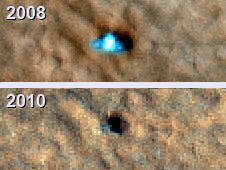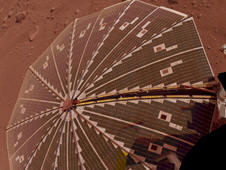|
|||||||||||
|
|
|
|||
|
By Mike Mitchell |
||||
 |
May 25, 2010 - NASA's Phoenix Mars Lander has ended operations after repeated attempts to contact the spacecraft were unsuccessful. A new image transmitted by NASA's Mars Reconnaissance Orbiter shows signs of severe ice damage to the lander's solar panels.
"The
Last week, NASA's
Mars Odyssey orbiter flew over the
Earth-based
research continues on discoveries
An image of
"Before and after
images are dramatically different," said Michael Mellon of the "The lander looks smaller, and only a portion of the difference can be explained by accumulation of dust on the lander, which makes its surfaces less distinguishable from surrounding ground." |
|||
| Two images of the Phoenix Mars lander taken from Martian orbit in 2008 and 2010. The 2008 lander image shows two relatively blue spots on either side corresponding to the spacecraft's clean circular solar panels. In the 2010 image scientists see a dark shadow that could be the lander body and eastern solar panel, but no shadow from the western solar panel. | ||||
 |
||||
|
This view of one of the Mars Phoenix
Lander's solar panels is a composite of multiple exposures taken
by the spacecraft's Surface Stereo Imager camera. |
||||
|
Apparent changes
in the shadows cast by the lander are consistent with predictions of how
During its
mission,
"We found that the
soil above the ice can act like a sponge, with perchlorate scavenging
water from the atmosphere and holding on to it," said Peter Smith,
The perchlorate
results are shaping subsequent astrobiology research, as scientists
investigate the implications of its antifreeze properties and potential
use as an energy source by microbes. Discovery of the ice in the
uppermost soil by Odyssey pointed the way for "Ice-rich environments are an even bigger part of the planet than we thought," Smith said. "Somewhere in that vast region there are going to be places that are more habitable than others." The Mars Reconnaissance Orbiter reached the planet in 2006 to begin a two-year primary science mission. Its data show Mars had diverse wet environments at many locations for differing durations during the planet's history, and climate-change cycles persist into the present era. The mission has returned more planetary data than all other Mars missions combined. Odyssey has been orbiting Mars since 2001. The mission also has played important roles by supporting the twin Mars rovers Spirit and |
| Other News Stories |
|
|
| ?AvStop
Online Magazine
Contact
Us
Return To News
|
|


